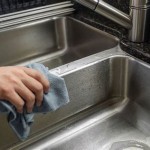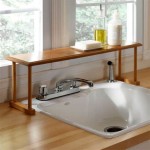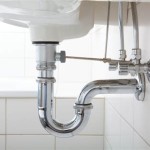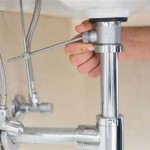Why Is My Sink Clogged On Both Sides?
A double-sided sink, typically found in kitchens, offers convenience with its separate basins. However, when both sides clog simultaneously, it indicates a problem beyond a simple localized blockage. This shared plumbing design means the two basins connect further down the drainage system, and a clog in this shared pipe affects both sides. Understanding the underlying causes of this dual blockage can help homeowners troubleshoot and potentially resolve the issue before calling a plumber.
Clogged P-Trap
The P-trap, a curved section of pipe located beneath the sink, is designed to trap water and prevent sewer gases from entering the home. This trap, however, can also catch debris like hair, soap scum, and food particles. Over time, this debris accumulates, eventually restricting and blocking water flow. In a double sink, both basins typically share a single P-trap or connect to a shared branch drain line just before their respective P-traps. Therefore, a clog in this shared section affects drainage from both sinks.
Clearing a P-trap can often be a simple DIY task. Placing a bucket beneath the trap to catch water, then loosening the slip nuts that connect the trap to the drain pipes, allows for its removal. The trapped debris can then be cleaned out, and the trap reassembled. If the clog persists after cleaning the P-trap, the problem lies further down the drain line.
Blockage in the Branch Drain Line
The branch drain line is the pipe that connects the P-trap to the main sewer line. This pipe often serves multiple fixtures, including both basins of the double sink. A blockage in this shared line will manifest as slow drainage or complete blockage in both sinks simultaneously. The blockage can be caused by the same debris that clogs P-traps, but can also include larger items inadvertently washed down the drain.
Clearing a branch drain line blockage is often more complex than clearing a P-trap. A plumber's snake, a flexible auger, can be inserted down the drain to break up or retrieve the blockage. Chemical drain cleaners can sometimes be effective, but their use should be approached with caution, following manufacturer instructions carefully. These chemicals can damage pipes if used improperly, and their effectiveness is limited against solid obstructions.
Clogs Further Down the Main Sewer Line
While less common, a clog in the main sewer line can also cause both sides of the sink to back up. The main sewer line carries wastewater from all drains in the house, and a blockage here creates pressure that can cause backups in multiple fixtures, including the double sink. This is often accompanied by gurgling sounds in other drains, slow drainage in toilets, or even sewage backups.
A main sewer line clog is a serious plumbing issue requiring professional intervention. The blockage may be caused by tree roots infiltrating the pipes, collapsed pipes, or a buildup of grease and debris. A professional plumber will have the tools and expertise to diagnose and resolve the issue, which might involve using specialized equipment like a motorized auger or hydro-jetting to clear the blockage.
Improper Venting
While not a clog in the traditional sense, improper venting can also cause slow drainage that mimics a blockage in a double sink. The vent system allows air to enter the drain pipes, preventing a vacuum that can slow or stop water flow. If the vent is blocked, inadequate airflow can lead to slow drainage in both sinks. This can be misdiagnosed as a clog.
Identifying a venting issue requires inspecting the vent pipe, typically located on the roof. Blockages, such as leaves or debris, can be removed. In some cases, the vent system may be improperly designed or installed, requiring professional correction. A properly functioning vent system is crucial for efficient drainage and preventing sewer gases from entering the home.
Hard Water Buildup
In areas with hard water, mineral deposits can accumulate within the pipes over time, constricting the diameter and impacting water flow. While this buildup isn't strictly a clog, it can have the same effect, causing slow drainage in both basins of a double sink. This is a gradual process and might be accompanied by reduced water pressure in other fixtures.
Addressing hard water buildup can involve several strategies. Regularly flushing the drain with a mixture of baking soda and vinegar can help dissolve some mineral deposits. Installing a water softener can prevent future buildup by removing minerals from the water supply. In more severe cases, a plumber might need to use specialized tools to remove hardened deposits within the pipes.

Why Is My Double Kitchen Sink Backing Up To The Other Side Flohawks Plumbing Septic

How To Fix A Kitchen Sink Clogged On Both Sides Expert Guide Clover Contracting

How To Unclog A Double Sink Clumsy Crafter

Both Sides Of Kitchen Sink Filling With Water Explained

How To Fix A Clogged Kitchen Sink On Both Sides

How To Unclog A Double Sink Clumsy Crafter

How To Unclog A Kitchen Sink Youtube

Why Is My Kitchen Sink Clogged On Both Sides Croppmetcalfe

Why Is My Kitchen Sink Clogged On Both Sides Ps Plumber Singapore

Kitchen Sink Clogged On Both Sides Do This Pv Heating Cooling Plumbing







